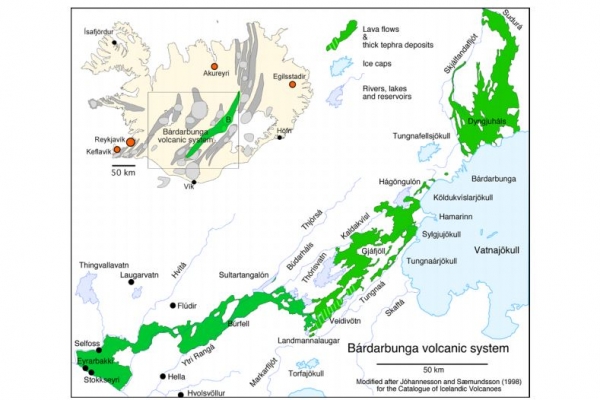An earthquake measuring 3.3 on the Richter scale occurred in Bárðarbunga yesterday. This is the third time in a week that an earthquake larger than 3 on the Richter scale is detected in Bárðarbunga. On Friday May 20 a 4.4 quake took place, followed by a 3.4 magnitude quake on Monday. A large number of smaller earthquakes have been recorded as well.
Read more: Seismic activiti in Bárðarbunga continues: A 3.4 magnitude quake yesterday afternoon
The Icelandic Meteorological Office notes that the seismic activity in Bárðarbunga has been increasing since the end of the Holuhraun eruption in February 2015. A total of 47 earthquakes of magnitude larger than 3 on the Richter scale have been detected around the Bárðarbunga caldera, 43 of them since 1st September 2015 and 33 since 1st January 2016. The strongest events were 4.2 magnitude earthquake on April 8 and the 4.4 magnitude earthquake last Friday, May 20. Satellite images indicate that geothermal activity in the caldera has also been growing.
Scientists are not sure what is going on in Bárðarbunga, but the Icelandic Met Office stresses that “despite the increasing activity, there are currently no signs of volcanic tremor.”
Increasing activity under Bárðarbunga in the last months might reflect magma accumulation below the volcano. However, other explanations have been considered; for example increasing water pressure in the hydrothermal system inside the caldera, pressure changes due to changing ice load or increased friction on the ring fault due to increasing magma pressure.
Bárðarbunga volcano, which is located in North-Western part of Vatnajökull glacier, is the second highest mountain in Iceland. It is also one of the most powerful volcanoes in Iceland, the centre of an enormous volcanic system which stretches from Dyngjuháls ridge in the north to Torfajökull glacier in the south. Scientists have warned that A major eruption in Bárðarbunga could easily dwarf the 2010 Eyjafjallajökull eruption which paralyzed air-traffic in much of North-Western Europe.

An earthquake measuring 3.3 on the Richter scale occurred in Bárðarbunga yesterday. This is the third time in a week that an earthquake larger than 3 on the Richter scale is detected in Bárðarbunga. On Friday May 20 a 4.4 quake took place, followed by a 3.4 magnitude quake on Monday. A large number of smaller earthquakes have been recorded as well.
Read more: Seismic activiti in Bárðarbunga continues: A 3.4 magnitude quake yesterday afternoon
The Icelandic Meteorological Office notes that the seismic activity in Bárðarbunga has been increasing since the end of the Holuhraun eruption in February 2015. A total of 47 earthquakes of magnitude larger than 3 on the Richter scale have been detected around the Bárðarbunga caldera, 43 of them since 1st September 2015 and 33 since 1st January 2016. The strongest events were 4.2 magnitude earthquake on April 8 and the 4.4 magnitude earthquake last Friday, May 20. Satellite images indicate that geothermal activity in the caldera has also been growing.
Scientists are not sure what is going on in Bárðarbunga, but the Icelandic Met Office stresses that “despite the increasing activity, there are currently no signs of volcanic tremor.”
Increasing activity under Bárðarbunga in the last months might reflect magma accumulation below the volcano. However, other explanations have been considered; for example increasing water pressure in the hydrothermal system inside the caldera, pressure changes due to changing ice load or increased friction on the ring fault due to increasing magma pressure.
Bárðarbunga volcano, which is located in North-Western part of Vatnajökull glacier, is the second highest mountain in Iceland. It is also one of the most powerful volcanoes in Iceland, the centre of an enormous volcanic system which stretches from Dyngjuháls ridge in the north to Torfajökull glacier in the south. Scientists have warned that A major eruption in Bárðarbunga could easily dwarf the 2010 Eyjafjallajökull eruption which paralyzed air-traffic in much of North-Western Europe.








